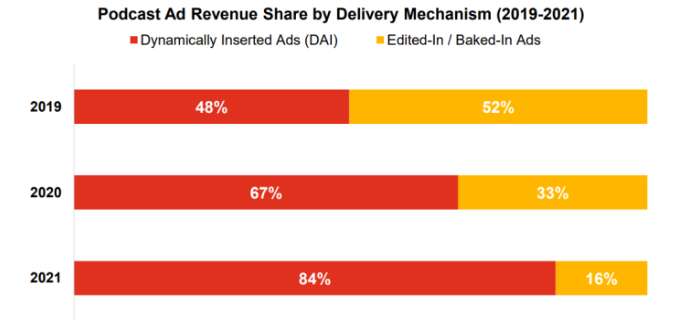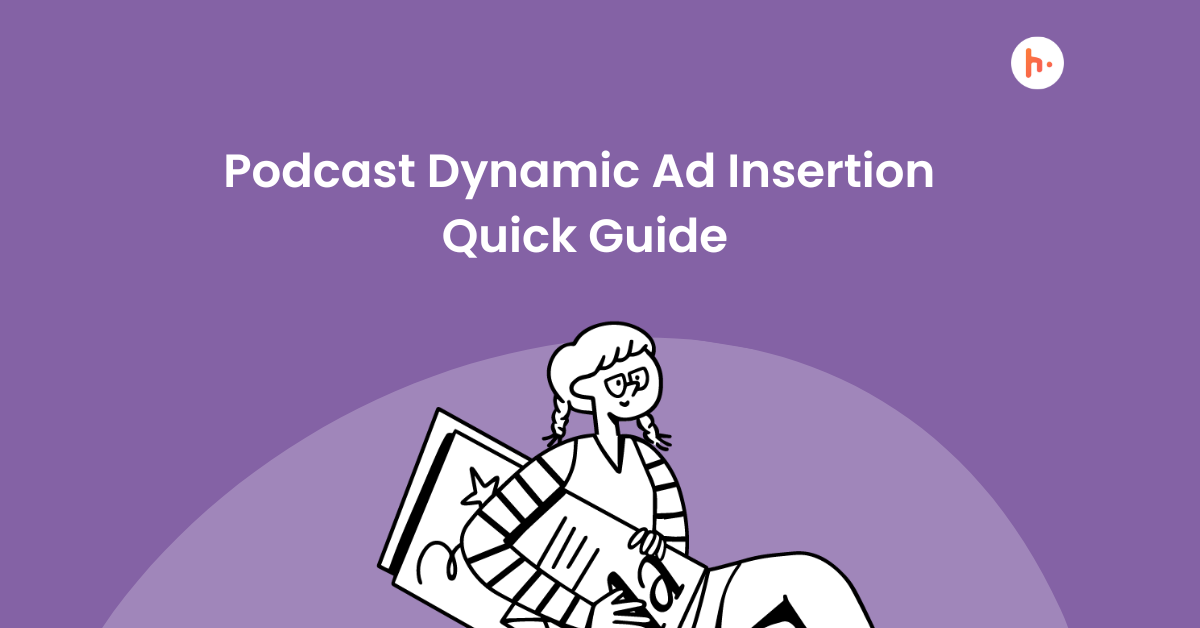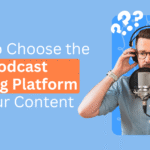The podcast ad industry has grown exponentially, with new game-changing technologies surfacing now and then. While the traditional host-read ads have been the standard so far, recent ad tech like Dynamic Ad Insertion (DAI) or programmatic advertising has become the new trend.

But what really is this trend, and how can you use it effectively to optimize your podcast monetization? This article will tell you everything you need to know about Dynamic Ad Insertion.
What is Dynamic Ad Insertion?
To put it in simple terms, a dynamic ad can be inserted, moved around, and removed from a podcast. This means dynamic ads are not a part of the original audio file and can be customized according to advertisers based on their ad campaign targeting. This also means that podcasters don’t have to commit their content to a single ad for a lifetime.
For instance, you want to optimize a podcast or a particular episode you recorded three years ago. Through DAI, you can easily remove the old dynamic ad stitched into that content and replace it with a brand new one. If listeners download that episode, they will hear the new ad, not the one that was originally stitched to the episode.
DAI doesn’t interfere with your podcast production and publishing process. All you have to do is record and publish your podcast episode as you generally do and then mark areas within that episode where dynamic ads will be inserted by a piece of software/tool after the episode has been published – usually in pre-roll, mid-roll, or post-roll slots.
How is Dynamic Ad Insertion different from Baked-In Ads
Usually, most ads are baked-in ads, which means they are a permanent fixture in the audio file and can’t be removed. They are almost always host read, but a sponsor can also create the audio ad and ask you to plug it in.
For instance, you get a sponsor who finds your content in alignment with their message. You either receive an ad script that you voice out during the recording in the relevant place (usually pre-roll, mid-roll and post-roll), or they share an audio clip that you stitch to the episode in the suitable space during editing. Once you publish the episode, that ad becomes a baked-in ad, a static part of the show.
Baked-in ads are ultimate when it comes to native advertising. They are most effective because the brands can leverage particular content to reach a specific audience. Dynamic ads help sponsors in the same way but also provide many more opportunities to enhance their ad campaigns.
How does Dynamic Ad Insertion actually work?
Dynamic ad insertion is essentially a technology that allows the insertion of an ad into a podcast episode through an ad server. When a listener downloads a podcast episode, the audio is sent to the ad server with a set of specific campaign parameters like geo-targeting, search behavior, what type of device they use, and their age. Based on those details, the server then finds a relevant ad that is inserted into the episode and sent back to the player for the listener to tune into.
As the name suggests, this technology is quite dynamic as it inserts ads into the episodes in real-time by referring to comprehensive user data. This ensures that not only can you change the ads being served on a whim but also optimize them by using highly targeted parameters.
For instance, a dynamic ad insertion platform could read your cookies on your computer/phone and see that you recently searched for a Blue Yeti microphone. Using this piece of information and other user data, the platform will stitch a relevant ad to the podcast episode you tune into. This means that if you and I tune into the same podcast show, we might receive different ads because we have different search behavior, interests, gender, ages, and locations, among many other things.
Benefits of DAI for podcasters
While dynamic ads come with a lot of advantages, here are some key benefits that attract podcasters the most:
They will always be relevant to listeners
One thing that DAI can ensure you is that your listeners will always receive ads that are relevant to them – ads they can always take action on. This is one of the USPs of dynamic ad insertion technology. It is specifically designed to streamline and create more targeted campaigns that are suitable for consumers in the present.
Suppose it’s Christmas and Big Festive Sale ads are running on your podcast. The ads will be relevant to your audience because the sale is in the process, but if they go back to that episode a month later, those ads will be replaced with ones that are relevant in that specific time frame.
That’s the beauty of dynamic ads. Not only are they relevant, but they are also a part of short campaigns with the highest yieldings.
You have the control remote
Sometimes, advertisers fall through or don’t pay on time. Unlike baked-in ads, you don’t have to stick to the ads and keep your end of the bargain. Dynamic ads allow you to edit an ad, replace it with a new one or remove it completely as you seem fit. The best part is you get to keep your listeners’ interest at the forefront. Each listener will receive an ad that is most relevant to them depending on their user data, creating a better podcast listening experience for them.
Dynamic ads are always fresh and new
Since dynamic ads are not a permanent fixture in your audio files and you have the ability to remove or change them after a campaign ends, the ads will remain fresh. Not only that, but dynamic ads will also give a fresh feel to your existing inventory, no matter how old it is.
For instance, Imagine a listener stumbles upon an episode you published four years ago. With any other traditional ad, the content will appear outdated and will most definitely lead the listener to a campaign/offer that does not exist anymore. However, with dynamic ads stitched to your old inventory, not only does it become relevant, but it will also make your content sound refreshed.
Listeners won’t notice a thing
Just like most podcast ads, dynamic ads are read by the host and have a similar placement in an episode. This way, they sound authentic. If done properly, your listeners won’t be able to distinguish a dynamic ad from a baked-in ad.
Drawbacks of DAI for podcasters
Like any other podcast advertising method, dynamic ad insertion has its own drawbacks. It mainly depends on the kind of sponsor you are partnering with. Sometimes sponsors invest in ads hoping that their ad will remain in the episode for a lifetime, or their ads might not transition well within your content, making it sound less organic. This can make the listeners hyper-aware of the ads.
Some listeners might also notice the change in ads from the last time they tuned into that specific content, though they are unlikely to care. In the end, you’ll have to weigh in your wins and your losses to see if DAI is suitable for your content or not.
Conclusion
Dynamic ad insertion has been a big part of major media. They are already effective when it comes to mediums like TV, radio, web pages, and social media platforms. Now that the trend has picked up in podcasting, a lot of advancements can be made.
Dynamic ads won’t entirely replace native baked-in ads as some podcasters and sponsors like traditional advertising over dynamic. However, there’s definitely a scope of DAI offering more opportunities to creators and sponsors alike.
The question is whether dynamic ads suit your podcast and audience. If yes, it’s time for you to jump on the bandwagon.





